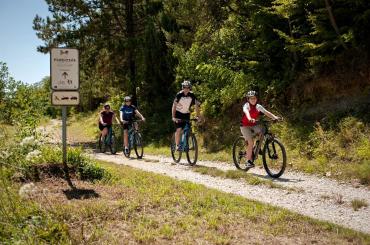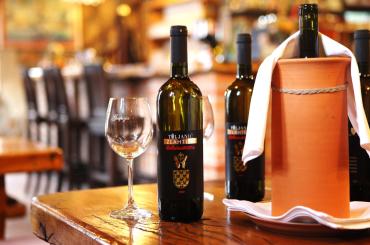RealCroatia's travel designers recommend visiting some of the secluded islands in the Croatian Adriatic. Seven of them are accessible by boat, and no cars are permitted onshore. One must move about on foot or by bike. You can always take an excursion to the nearby UNESCO protected architecture and nature, world-class restaurants and immerse in other local delights - we can plan whatever suits your taste!
#1 Unije – wheelbarrow or plane, but no cars!
Unije is a small island, just under 17 sq. kilometres in size and 10 kilometres long. With a population of fewer than 100 people, this tiny paradise is in the shadow of the island five times larger, Lošinj. Cars don't circulate there because of the narrow streets, and the primary means of transport is the wheelbarrow. However, there is a small airport on the island if you need to get there without much fuss.
 Photo: s74
Photo: s74Unije island is a part of the Cres Losinj archipelago in the Adriatic Sea
The northern part of the island is of particular ecological importance since it is on the route of migratory birds (birdwatchers, wink-wink). Known for its olive oil since the time of the Roman Empire, the whole island was once an olive grove.
Use the small airport to get to Unije without too much fuss
You could easily spend your days doing a mixture of relaxing and safely exploring this peaceful and quiet destination by bike or on foot.
#2 Susak – no roads, no cars, no clubs
Susak has the tightest "American connection" of all the islands on the list. In the 1960s, mass emigration to the USA depleted the population, and today there are 2500 Susakers in America, mainly in the state of New Jersey. From 1985 onwards, "Emmigrants' Day" was celebrated on Susak on the last day of July.
Susak is a unique island in the Adriatic Sea because of its genesis and appearance.
 Photo: Paul Prescott
Photo: Paul PrescottBeautiful Mediterranean white stone house with blue windows and doors in Susak
The ancient winds deposited thick layers of fine yellowish sand onto the limestone plate, and since time immemorial, people planted reeds around their fields. In search of water, the roots of the reeds penetrated deep into the soil and protected it from erosion.
The first settlement, dating back to Roman times, was built on the fertile plateau and is called Gornje Selo ("the upper village"), while Donje Selo ("the lower village") is located in the harbour. It was built later, during the most significant boom of grape growing in the late 19th century. Because of its isolation, Susak has preserved its archaic speech (protected as a part of the cultural heritage) and the specific customs and colourful traditional costumes.
Susak is home to shortest popular costume in Europe - the only one not covering the knees
Susak is known for its numerous sandy and shallow bays. There are no roads on the island; there are no cars, clubs and loud noises, only kilometres of trails connecting the village to remote bays. During the day, small tractors with trailers circulate on the island, delivering the goods ferried by the ship. A Susak's peculiarity is its popular dress - the shortest popular dress in Europe and the only one that does not cover the knees.
#3 Silba – no cars by popular decree
Silba's only village is also called Silba. It is situated at the narrowest point on the island, where Silba's bays Mul and Žalić are at the nearest point. Nowadays, its permanent population is just under 300 people.
 Photo: JGA
Photo: JGAAn old stone made tower called Toreta is known as the tower of love on island Silba
Silba had a fleet of hundred sailing ships in the 18th century, but people are mainly into tourism nowadays. Silba is often called "the door of Dalmatia". This island is an oasis of peace: cars don't circulate here. Seafarers and sailors from Silba protected themselves from the machines with a decree sanctioned by all the inhabitants. The best-known attraction of the island is undoubtedly Toreta, the tower with an external spiral staircase. According to legend, in the 19th century, Petar Marinić built it as a reminder of love never forgotten.
#4 Zlarin - the island of coral jewellery
Zlarin is an island near Šibenik. Zlarin is a car-free green island, a paradise for children, ideal for a relaxing holiday, for those who love taking walks and bathing in the crystal clear sea. There are about 2700 hours of sun yearly, making Zlarin one of the sunniest islands of the Adriatic sea.
 Photo: Brch
Photo: BrchThe Island of Zlarin near Šibenik is famous for its waterfront and coral jewellery
All over the world, it is known for its corals – here, the jewels and coral objects are still traditionally manufactured since the fifteenth century. The first written documents about Zlarin date back to 1245, but archaeologists have found objects from the Neolithic and Roman periods. Since 2019, it is the first Adriatic plastic-free island where disposable plastic objects are prohibited (just like cars).
#5 Prvić - coves, macchia, vineyards and olive groves
Prvić is a small island in the vicinity of Vodice. There are two typical Dalmatian fishing villages on the island: Prvić Luka and Šepurine, connected by a 1 km long road that you can cross on foot or by bike as motorised traffic is prohibited here. This island is the closest to Šibenik and the coast.
Fausto Veranzio, 17th century scientist and inventor, spent his childhood in Prvić Luka
Hence its name is Prvić - "the first". Covered in Mediterranean macchia, vineyards and olive groves, with indented coves, Prvić is located in the Šibenik archipelago near Vodice. The island is 2.4 square kilometres in size and has 400 inhabitants, making it the third most densely populated island in Croatia.
 Photo: Brch
Photo: BrchColourful Mediterranean stone street of Prvić island, situated in the Šibenik archipelago
It is also called "the Island of Fausto", according to Fausto Veranzio, the famous scientist and inventor from the seventeenth century who spent his childhood in Prvić Luka.
#6 Lopud - the perfect alternative to mass tourism
Lopud is a small island with a long maritime tradition, without cars and roads, and it symbolises a perfect alternative to mass tourism of the nearby Dubrovnik. The island boasts a long history, of which you can find evidence: remains of medieval churches, fortresses, summer houses and a splendid Franciscan monastery.
 Photo: Popova Tetiana
Photo: Popova TetianaLopud is an island located just 20 minutes ferry ride away from Dubrovnik
The right place for relief from the heat is the Đorđic-Mayneri park, full of palm trees, pine trees, and flowers. Lopud also boasts one of the most beautiful beaches, Šunj, where you can wade through the warm water and play in the shallow sea.
Lopud and Koločep are situated right next to Dubrovnik
Due to an agreeably mild climate, with an annual average of 2,584 hours of sunshine, this economically prosperous island is covered in lush Mediterranean vegetation.
#7 Koločep - one paved road, zero cars
Koločep is located just 20 minutes boat ride away from Gruž, Dubrovnik's main ferry port. Koločep is also the smallest of the three inhabited islands in the Elaphiti archipelago, with an area of just 2.6 sq kilometres and just under 160 permanent inhabitants. It is genuinely the corner of paradise. There are no roads on the island; the only paved road is the one that connects two fishing villages – Gornje Čelo and Donje Čelo.
 Photo: WitR
Photo: WitRDonje Čelo is a village on the island of Koločep situated near Dubrovnik. The only paved road leads to nearby Gornje Čelo village
It is wide enough for pedestrians, but not for cars. With its clear waters and beautiful rocky and pebble beaches, the island is a favourite refuge from the summer crowds for the locals. Walking or kayaking around and spare a couple of hours for swimming, sunbathing and snorkelling here. In the evening - try local food and wines.




